| 1 | Eastern hognose snake |
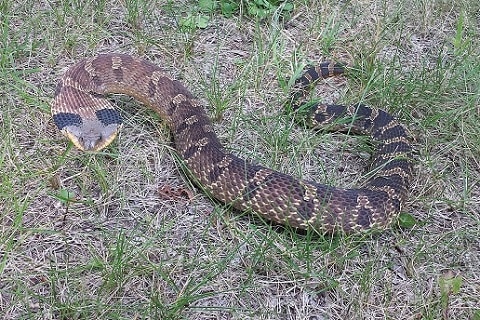
Maximum length: 115.5cm.
The eastern hognose snake is a local character that every Floridian or Georgian knows, with an average length of 70cm. Something you may have witnessed if you’re lucky is their over-the-top play dead theatrics. Eastern hognose snakes (Heterodon platirhinos) produce venom, but only via their rear fangs, forcing them to chew potential predators if they wish to defend themselves.
So instead, the eastern hognose snake takes the deception route. They begin by writhing around as though in full scale death throes. Then they suddenly flip over onto their back, leaving their white-grey belly facing the sky. Next, they open their mouth wide, and loosen their body as though completely limp. The eastern hognose snake also releases a foul-smelling liquid, to mimic the graveyard small of death.
Worse, as the hognose snake initially thrashes around, this disgusting liquid will get smeared all over the place. By the time a hungry bird appears with its talons outstretched, the eastern hognose snake will be unmistakable for a corpse, forcing predators to reconsider whether they should find a fresh meal. According to a 2021 review, the eastern hognose snake has more death-faking skills than any snake in the Americas.
| 2 | Banded coffee snake |
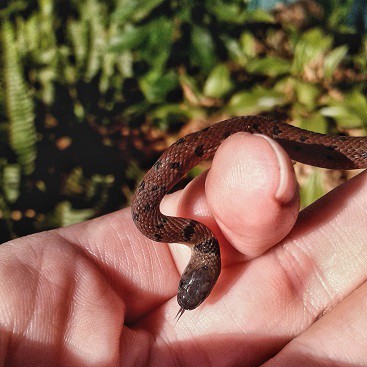
Maximum length: 40cm.
A peaceful snake of rainy Central American villages. This species appears in Nicaragua, Panama and Honduras, but is overwhelmingly most common in Costa Rica. The banded coffee snake (Ninia maculata) is common in rainforests, but also disturbed human zones nearby, such as crop fields or people’s back gardens. This is a non-venomous snake, which loves to hang out below shelter feeding on worms. They’re most commonly encountered by locals when lifting up old pieces of wood.
The banded coffee snake has been witnessed playing dead several times. They start by contorting their body, then flipping over to show their black and white checkered belly. They often loll their tongue out lifelessly as well. They can stay still for ages, waiting for the coast to clear. In one sighting on November 8th 2007, a banded coffee snake didn’t move a muscle for 5 minutes. This took place in Chiriquí Grande, Panama.
Banded coffee snakes have another defensive trick as well – spreading their ribs and flattening their upper body, to look wider than they really are. A banded coffee snake can flatten itself so much that there appears to be no room for its internal organs.
| 3 | Grass snake |
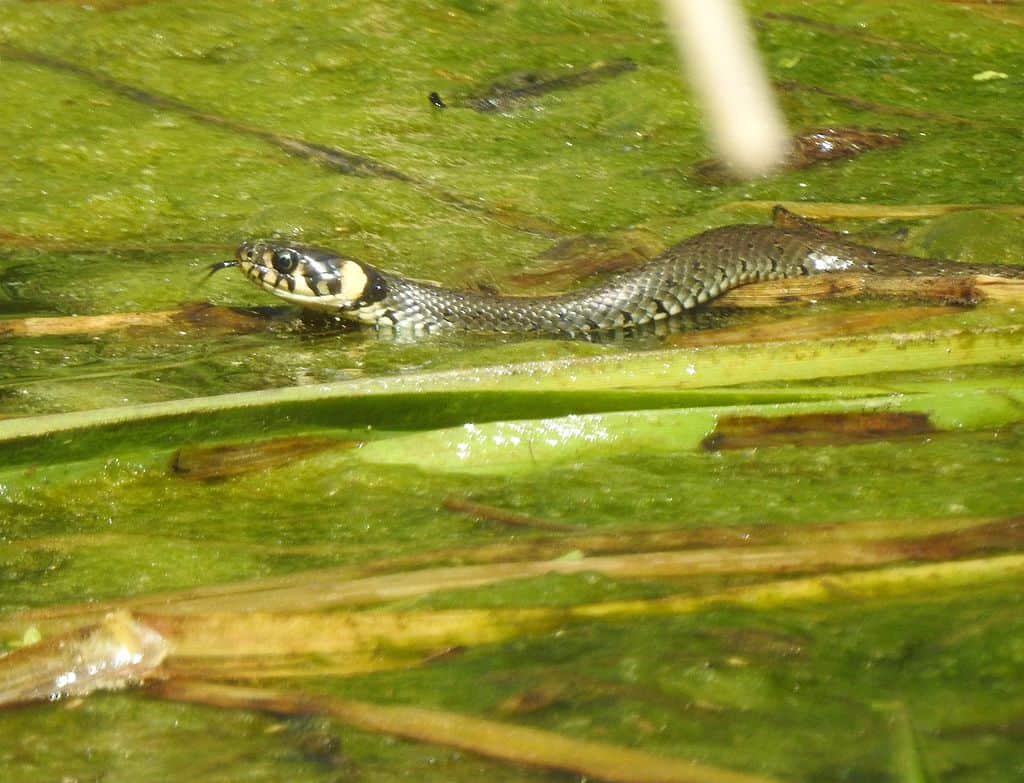
Maximum length: 205cm (but usually 1 metre or less).
The UK’s most common snake, which actually hangs out in water more often than grass. Grass snakes don’t launch into Shakespearean overacting with their play dead strategies, but the lifeless end result is actually one of the most convincing.
This snake goes completely limp when spooked, and nearly always opens its mouth wide and lolls its tongue out. They also curl themselves into a ball, and go so floppy that some sections of their body cross and end up tied in a knot. Fortunately, grass snakes have a natural instinct for untying themselves (unlike those annoying headphone cables).
The grass snake’s glassy, circular-pupiled eyes also make them particularly convincing. One study found that hatchling grass snakes never play dead, but that 66% of all adults did when confronted. This is a skill that clearly comes with age. Grass snakes can remain motionless for many minutes, and when the predator leaves, their revival always begins the same way – with a small wag of the tongue.
| 4 | Indian wolf snake |
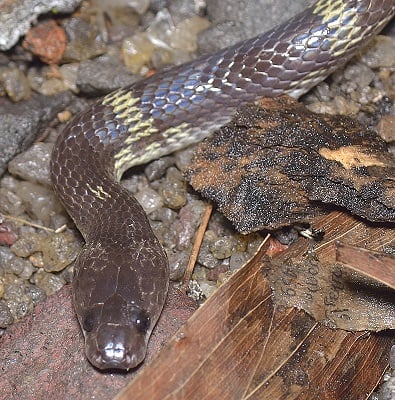
Maximum length: 84cm.
This chocolate-brown snake is one of India’s most common by headcount. Its priorities are rather out of whack, as it’s known for invading houses, yet is utterly fearful of humans. When confronted, the Indian wolf snake will react in one of two ways: 1) biting savagely with its non-venomous fangs, or 2) going completely floppy and lifeless. Like other snakes, they’ll flip onto their backs and show their brighter belly scales to complete the ruse.
In one case from Mumbai reported in 2011, a “dead” Indian wolf snake actually fooled some researchers into leaving the room. When they returned 30 minutes later, they were shocked to see it slithering around as normal. In a 2010 tale on a rural road, the Indian wolf snake started its defence by coiling up tight into a ball, probably to protect its brain. The photographers uncoiled the snake by hand, wanting the perfect shot, and this contact was the trigger for it to go floppy and limp.
The Indian wolf snake (Lycodon aulicus) has 2 morphs which coexist: one with simple white markings, and another with more complex markings. Strangely, scientists have only observed this death-feigning deception in the second morph, even after they severely provoked the first.
| 5 | Checkered keelback |
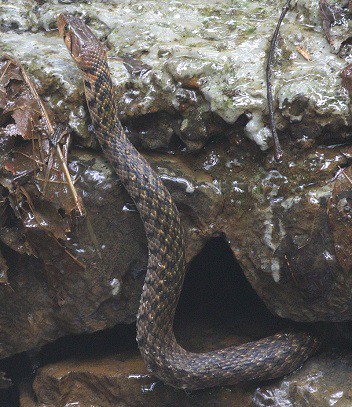
Maximum length: 175cm.
Another non-venomous Indian species, which nevertheless has an aggressive personality. The checkered keelback (Fowlea piscator) lives in lakes and ponds, and primarily preys on fish and frogs. This species had one of the creepiest encounters among play dead snakes. It involved a 140cm female in captivity, which was picked up, and began by snapping a couple of times aggressively. After 2 minutes, the keelback slowly began to go limp. Its muscle tone weakened, and the snake went floppy in the scientist’s hands. Its tongue was hanging out, in a complete image of death.
Yet despite the act, the snake’s eyes were still moving, still following the scientists from side to side. Its body was practically dead, yet its crafty eyes were as alert as ever.
The scientists dropped the checkered keelback on the ground, and 1 minute later it reactivated. They then picked up the keelback again, and it was like pushing a button, as the floppiness instantly returned. This time, even the snake’s eyes stayed still. Checkered keelbacks also use the defensive skill of detaching their tail (to escape a predator’s grip), which doesn’t grow back.
| 6 | Mozambique spitting cobra |
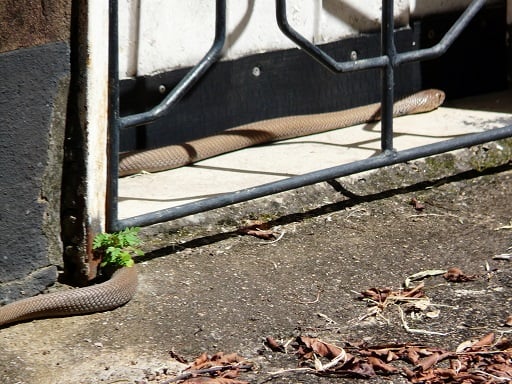
Maximum length: 180cm.
The main spitting cobra of South Africa, Zimbabwe, Botswana and Mozambique. Most of the snakes on this list are non-venomous ones which must use alternative tricks for survival. But the Mozambique spitting cobra is venomous to the extreme, yet still has a back-up play dead strategy. This snake throws everything into its attempts to survive the African countryside, which might be one reason why they’re so widespread.
Mozambique spitting cobras don’t even choose one strategy over the other. They can spit wildly at an aggressor initially, aiming for the eyes to incapacitate them via blindness, before suddenly flipping to playing dead minutes later. The observations of this deception have also come during the last 30 minutes. The Mozambique spitting cobra is apparently less advanced than some, as it just goes floppy and limp, without bothering to flip over fully. Instead, they only turn over their neck area.
Nevertheless, the Mozambique spitting cobra holds its nerve well, and can be picked up by a steel snake hook without breaking its death-feigning act. After a Mozambique spitting cobra was moved to nearby rocks by researchers, it stayed still for another 4 minutes, before the first subtle tongue flecks restarted.
| 7 | Colombian long-tailed snake |
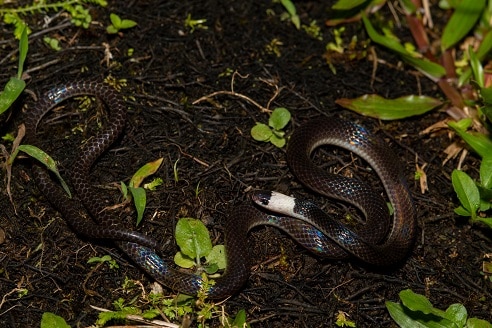
Maximum length: 55cm.
This species does inhabit Colombia, but is actually much more abundant in Costa Rica and Panama to the west. The Colombian long-tailed snake (Enuliophis sclateri) sticks to heavily forested regions, commonly making a den inside a rotting log. It’s rare for this snake to appear in villages, although they’re occasionally sighted in overgrown banana plantations. This is a shy species which is instantly recognisable by its white head contrasting against a dark brown body.
The Colombian long-tailed snake has an extreme long, yet fragile tail. This often snaps off as hungry eagles seize them in their talons, but keeps moving for hours afterwards, to draw attention away from the living snake trying frantically to escape. Playing dead is another of their deceptions, and this snake tends to flip over fully, showing its creamy white belly to the sky. They also fold themselves into a series of loose coils, to act as though they’re completely limp and dead.
Enuliophis sclateri doesn’t convulse like a hog-nosed snake, but they do gape their mouths open wide. They’ve been witnessed staying still for 2 minutes before. Colombian long-tailed snakes also have the special feature of fluorescence, which scientists discovered while prowling the Panamanian jungle for scorpions. At 22:00pm, they were swinging a bright torch around, which landed on a long-tailed snake and made it seem unusually bright.
| 8 | Queen snake |
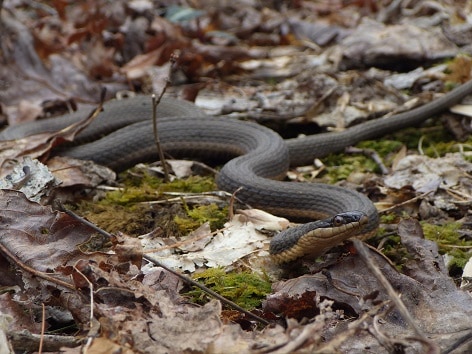
Maximum length: 94cm.
This rare American species mainly relies on its rocky grey camouflage to stay alive, but they’re extremely capable death-fakers when they do decide that it’s necessary. The queen snake is a semi-aquatic species of the eastern USA, which always lives in flowing water bodies rather than stagnant swamps. It’s a snake which eats 90% crayfish, particularly newly moulted crayfish which lack pincers to defend themselves with.
Queen snakes are docile and mainly thrash around and bite when picked up. Sometimes though, an obscure snake instinct is set off, and they launch into a fully committed play-dead performance. In 2017, researchers were tracking and recapturing queen snakes along riversides. When they picked up two juveniles, they flipped onto their backs, went floppy, and stayed motionless for 10 minutes.
From above, queen snakes are a similar metallic grey all over, which blends perfectly with the rocky streambeds they prefer. Nevertheless, queen snakes aren’t complacent, and they stop at nothing to convince predators that all life is extinguished from their bodies. Scientists captured images of the charade here, showing a queen snake facing down into the cold rock of the riverbank, with its eyes totally invisible.
| 9 | Brazilian smooth snake |
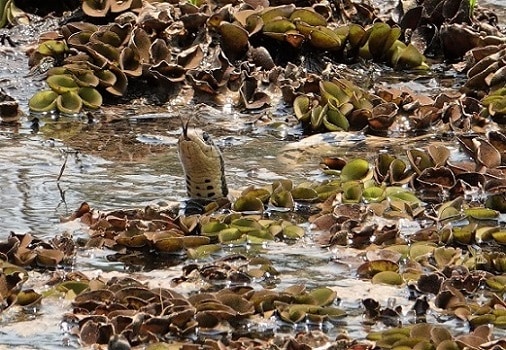
Maximum length: 300cm.
The largest play dead snake on our list. The banded coffee snake has only 60cm to go limp with, but the Brazilian smooth snake (Hydrodynastes gigas) is responsible for 2 whole metres of snake, occasionally 3 metres. This snake lives in rivers and marshlands of South America, staying away from the densest rainforests. It’s also called the false water cobra, for its ability to flare an intimidating neck hood, without being a real cobra.
When gripped, the Brazilian smooth snake’s first move is to bite and thrash, in a determined attempt to escape. But the more pressure you apply, the more likely it is you’ll activate death-feigning mode, where the snake goes completely limp. Brazilian smooth snakes sometimes loll their tongue out lifelessly, though not always.
One study searched for this species in Brazilian wetlands, and found that 5 of 13 played dead when harassed. However, Brazilian smooth snakes have very inconsistent personalities. Some are docile, and will probably resort to death-feigning, but others are savage and aggressive. Expect anything when you enter a Brazilian marshland.
| 10 | Dice snake |
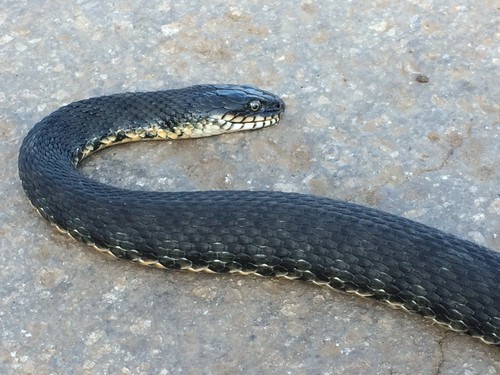
Maximum length: 130cm.
The dice snake (Natrix tessellata) is the grass snake’s eastern European cousin. Consequently, they too have an automatic death-faking instinct ingrained in them, although they use it slightly less commonly. Dice snakes live in the rivers of Serbia, Austria, Hungary, and more, and when picked up, they’ll usually go completely lifeless in your hands. Their mouth will open and their tongue will loll out, quite similarly to a grass snake.
However, the dice snake is also able to fill its own mouth with blood. This forms small red bubbles, which trickle from its open mouth in a bloody foam. A dead snake would never actually have a bloody mouth, but the deception still works, as the mere sight of blood causes some predators to assume they’ve found a corpse. Like grass snakes, juvenile dice snakes hardly ever fake death, whereas adults do so more and more as they age.
A dice snake’s first strategy when encountered is to hiss. Stage 2 involves widening the neck slightly, and when picked up, they may writhe and thrash, but rarely bite. Feigning death is their last ditch attempt.
